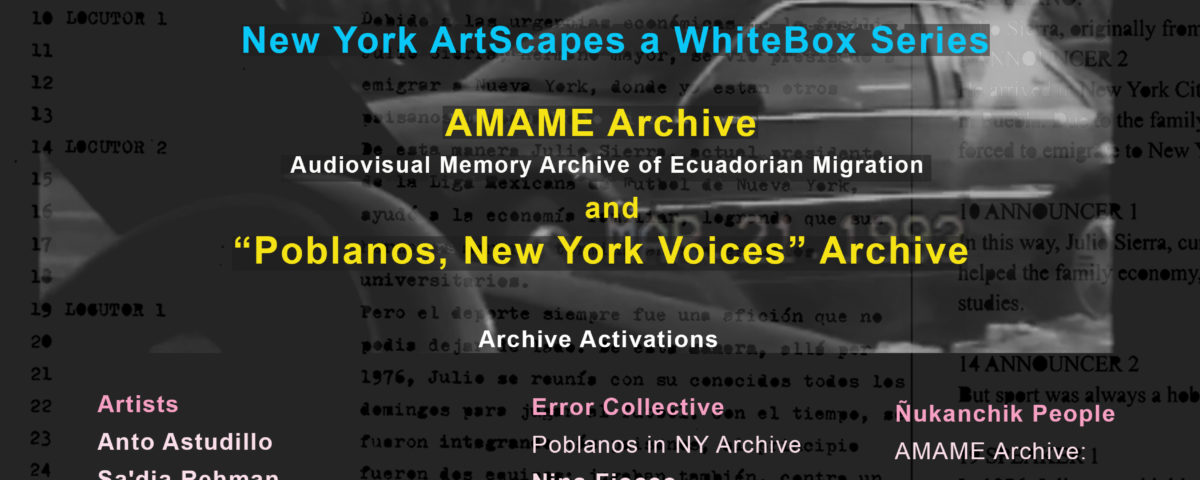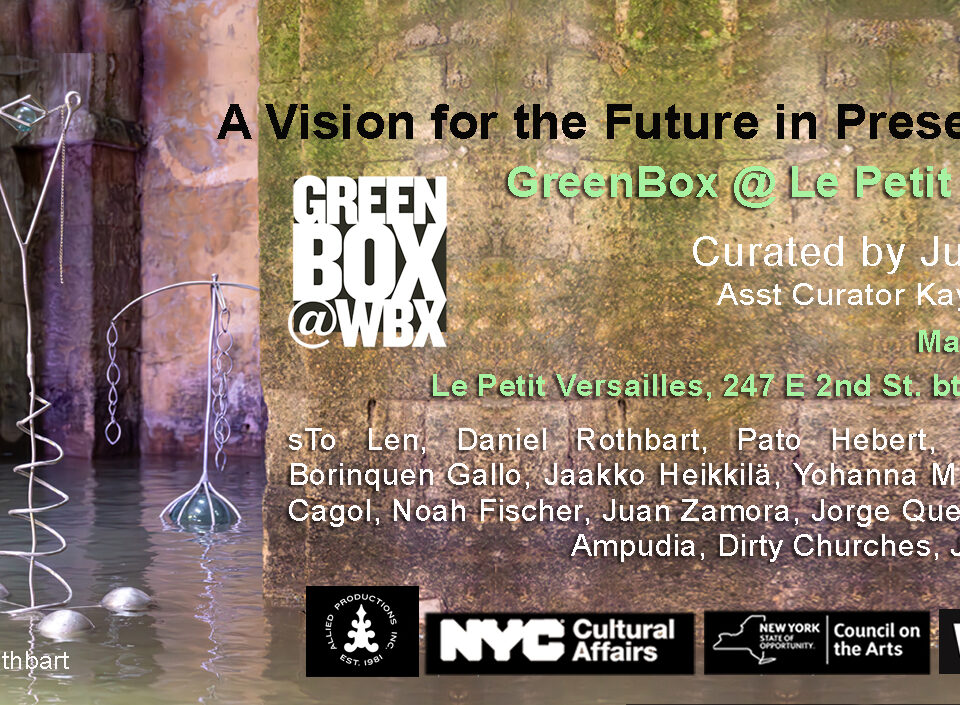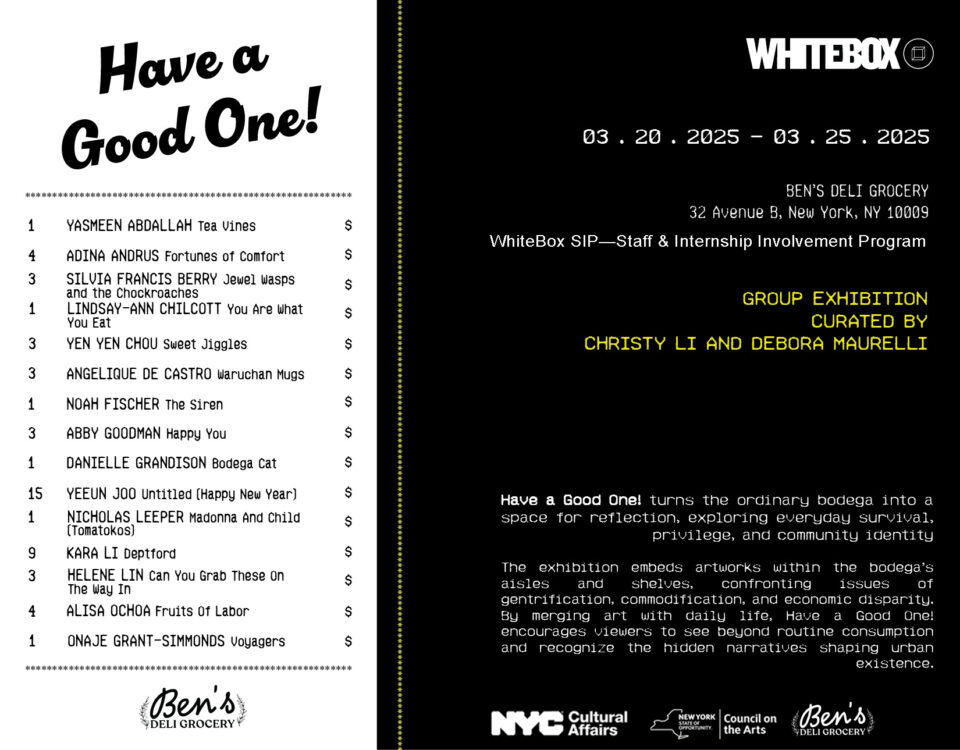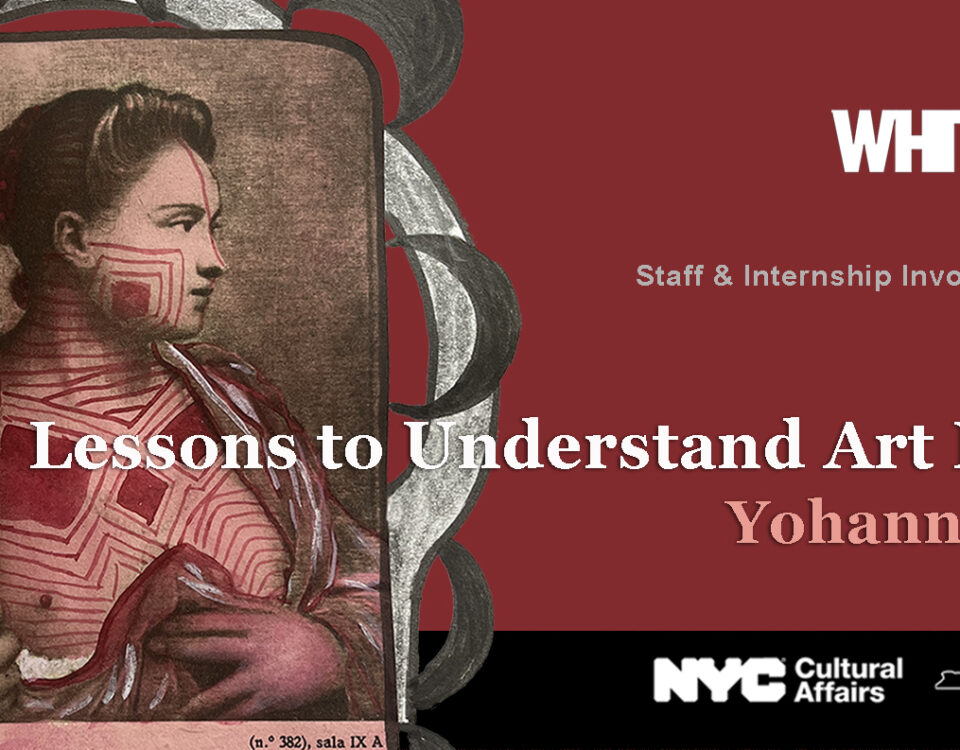
Slug´s Dizzy Gillespie All-Stars
February 7, 2024
“Otra Postal Aquí y Allá” ArtScapes WhiteBox New York Serie
March 10, 2024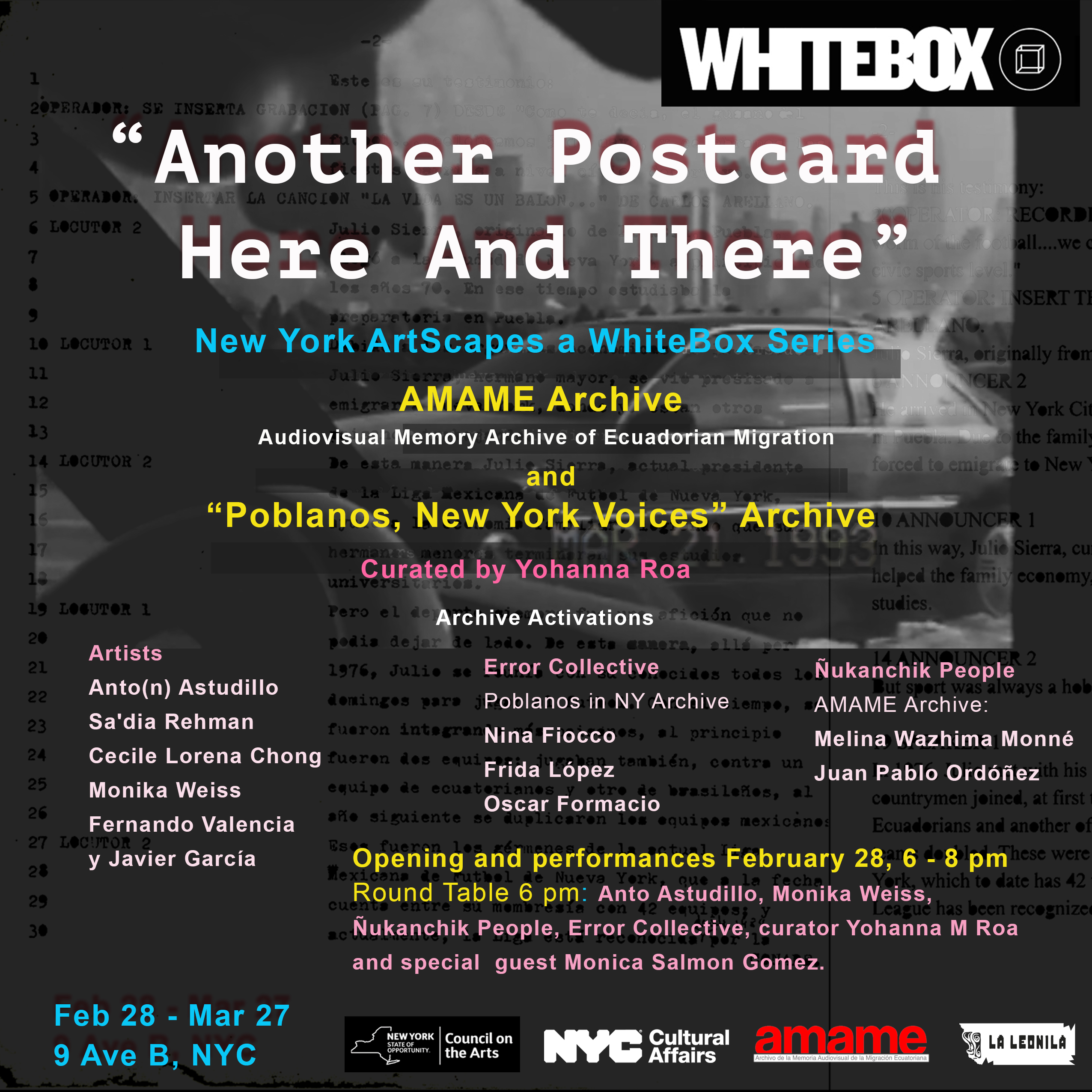
“Another Postcard Here and There” WhiteBox Series New York ArtScapes Curated by Yohanna Roa
The reality of New York City is different for workers, many of them immigrants, who make long journeys to their workplaces every day and generally receive the minimum wage. This reality is far from the New York of the postcards sold in Museums, where an idealized city, large skyscrapers and cosmopolitan artists can be seen. These images do not reflect that behind that landscape, there is a human workforce that must deal with the cost of living in the city. The exhibition “ Another Postcard Here and There” is part of the WhiteBox’s series “New York ArtScapes” (the first investigation was Taller Boricua, From Art Workers Coalitions Through Today). These are activations and expansions of archives related to the city of New York, which seek to open and show the complexities of cultural production in the city, which do not have real recognition by the discourse of power, which usually adds " what is not the white man", as a “kind of contribution” to the Relevant Official History with a capital letter.
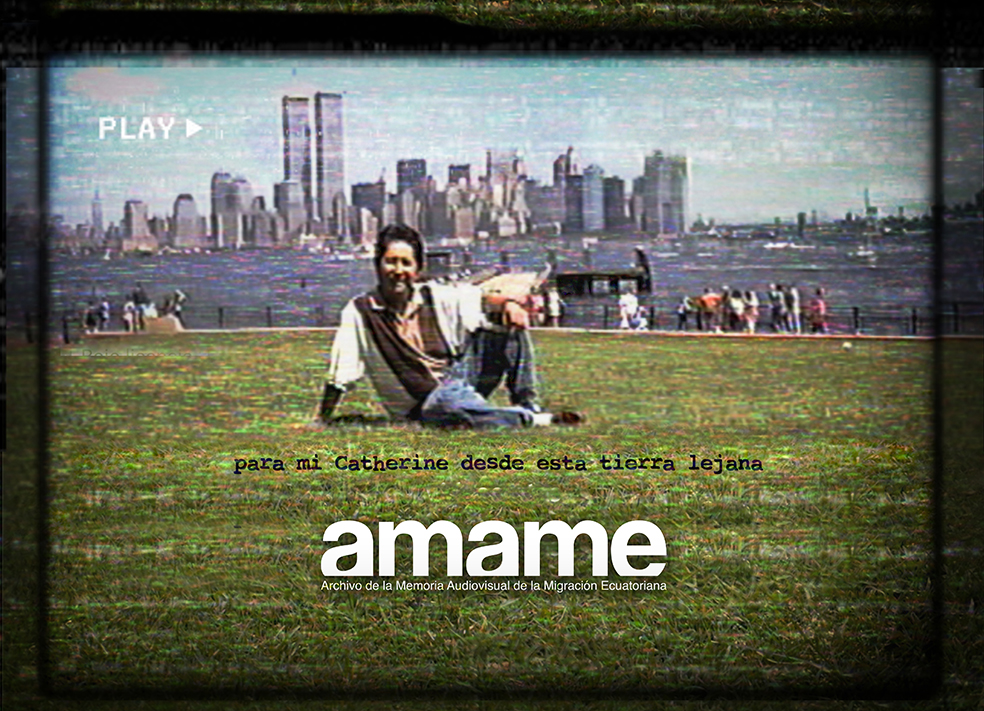
Ñukanchik People
Archivo de la Memoria Audiovisual de la Migración Ecuatoriana (AMAME)
Ñukanchik People (Ecuador): Juan Pablo Ordóñez y Melina Wazhima Monné.
400 hours (approx.) digitized video letters, indexed and navigable through a web device.
Founded in 2008 / Online version 2023
After two years of work, I have located two archives produced in this city in connection with Latin America. The first is the AMAME archive (Audiovisual Memory of Ecuadorian Migration Archive), which preserves the video letters of nearly a hundred Ecuadorian families (mostly based in NYC) who exchanged video correspondence to cope with the separation, distance, and nostalgia during their migratory processes between 1976 and 2010.
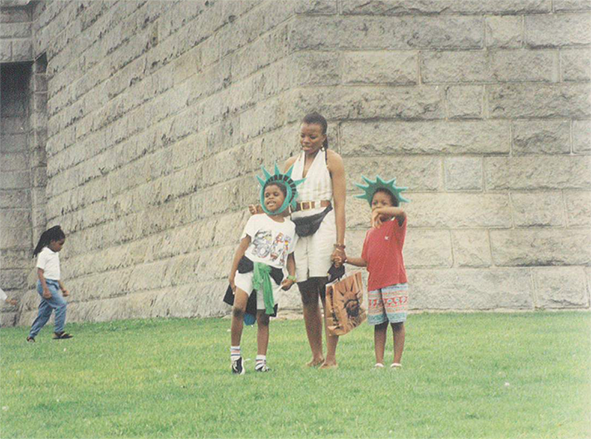
"Poblanos. Voces de Nueva York"Archive document
The second archive is “Poblanos, Voces de Nueva York,” which contains a series of materials inherent to the activities of a radio program carried out between 1992 and 1993 by Oscar López in collaboration with Enriqueta Silva and Carlos Arellano. In which the inhabitants of the city of Puebla, Mexico, based in the city of NY, narrate their personal experiences and their living conditions.
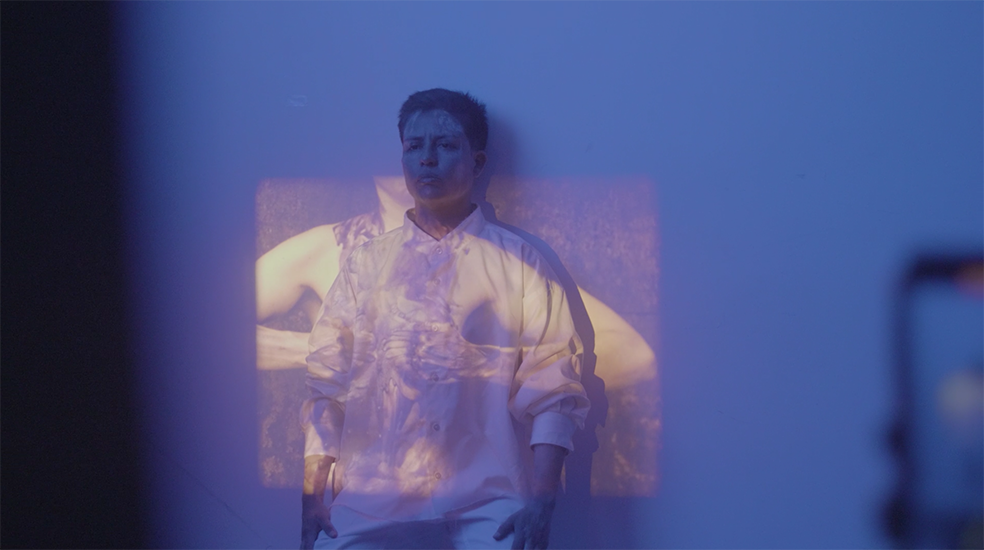
Anto(n) Astudillo
The exhibition also presents archives of activations by NYC-based artists Anto Astudillo, Sa'dia Rehman, Cecile Lorena Chong, Monika Weiss, Fernando Valencia, and Javier García. Error Collective, Poblanos in NY Archive: Nina Fiocco, Frida López and Oscar Formacio. Ñukanchik People, AMAME Archive: Melina Wazhima Monné and Juan Pablo Ordóñez.
In my experience as a curator, historian, and archivist, I believe that the past is something that we can transform because, far from being a line of truths or certainties, the past is a construction that involves points of view, positions, and exercises of power. I have developed the concept of matriarchive and defined it as a place of enunciation that operates as an organic network, a matrix capable of assembling relationships and archival experiences. From this concept, artists can activate the documents, but by connecting them with their present reality, the problems are relocated to the current time and place, with roots in the past. Although the exhibition focuses on documents from both archives, it is through artist activations that we can observe the past and interpret it differently, connecting it with the present.
I have developed two exhibitions with a similar methodology. JMA Matriarchive in Resistance was based on the archive of a Mexican architect who participated in social movements during the 60s and 70s in Europe, Africa, and South America. For the exhibition in NY, I invited local artists to connect the matriarchive: Territory under discussion for the Museo la Tertulia de Colombia in which my interest focused on the use of the Museum's archive to make evident the problems of social class, race, and gender, present in the museum's collection.
“Another Postcard, Here and There” is a curation that connects and expands the memories of immigrant workers from Ecuador and Mexico with the current NYC, a hyper-gentrified city. This exhibition expands on romanticized postcards to reveal how, daily, a group of inhabitants constitute the city´s identity.
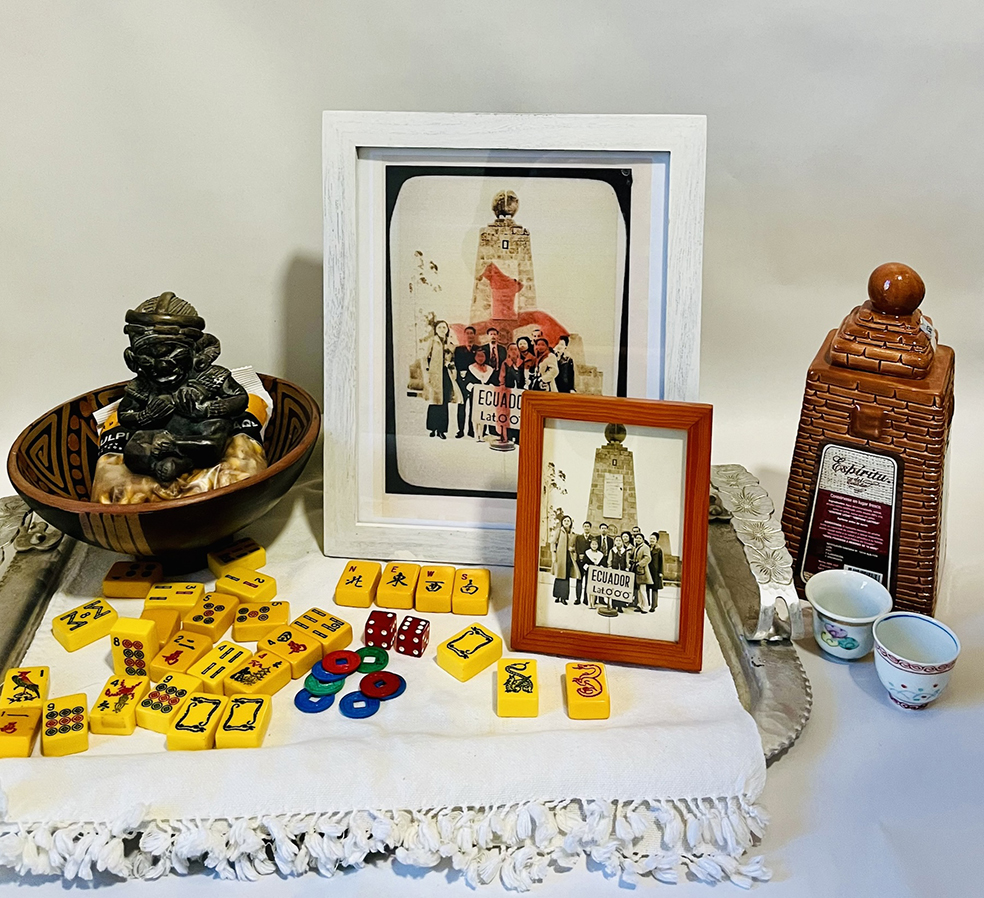
Cecile Chong
Middle Kingdoms, 2024
Mixed Media – Family photograph, Mahjong tiles, Ecuadorian liquor and snack, Ecuadorian figure and bowl,
Chinese teacups. 15 x 30 x 15 inches
Cecile Chong is a New York based artist, was born in Ecuador to Chinese parents and grew up in Quito and Macau. Her Mixed Media work ¨Middle Kingdoms¨ reflects on her family’s roots in Ecuador and China and includes a family photo taken in the 1970s at ¨El Monumento de la Mitad del Mundo¨ (The Middle of the World monument) outside of Quito. In Chinese, China is written as the middle kingdom 中國; she layered the image of the photograph on a mahjong tile that represents the middle 中. Mahjong is a tile-based game developed in China in the 19th century.
The artist remembers the family’s love and obsession with Mahjong. The Chong´s grandmother, Carmen, played Mahjong almost every day during the five years that she lived in Macau with her and her mom has a record of playing Mahjong for 48 hours straight during her high school years in Quito. While playing, the four players would drink tea or liquor, have snacks, smoke, and pause for meals. In New York, Chong was intrigued when she discovered a different look at the Mahjong game. In the 1930s, in the US, the Jewish community embraced it and adapted the tiles with Western characters. A red dragon has replaced the “middle” character in this set. Playing Mahjong is a way for many Chinese immigrants worldwide to cope with separation and distance from their families. The game also echoes common themes that all immigrant communities share, the hope for luck, prosperity, and a better life.
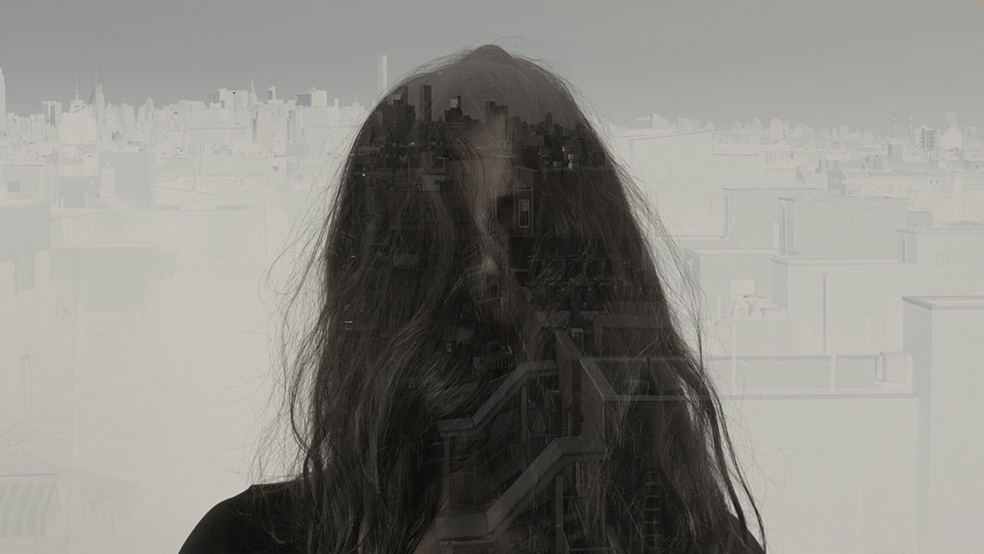
Monika Weiss
diaspeirõ
2024
acoustic vocal music and digital sound composition, 4K digital film . 6 minutes 56 seconds
Credits: “Metamorphosis” for voice a capella, composed by Monika Weiss. Vocalist: Ingrid Piazza, Recording engineer: Jeff Allen, Speaking voice: Saludos Desde Hamburgo, Guayas-015 Archivo AMAME /NKP-ECU, Camera and Editing: Monika Weiss, Movement performer: Madeline Aleman, Text 1: “diaspeirõ” by Monika Weiss , Text 2: “duerme el viento” is line from the poem La noche y mi dolor by Dolores Veintimilla de Galindo (1829-1857), accessed at Círculo de Poesía. Revista electronica de literature, año 12, No. 20, mayo 2020
Monika Weiss is a New York-based Polish artist who developed her work diaspeirõ, an acoustic vocal music and digital sound/image composition, by combining part of the audio from a video from the AMAME archive with her personal experience as an Immigrant. The audio is the Ecuadorian immigrant woman voice, who speaks to her son from Hamburg: "So Abdul, from Germany, I send you a big hug, your mom loves you very much and then look here I have a photo [ ...] ¨. Although the artist does not compare the life circumstances of this Ecuadorian woman with her own, she manages to establish a connection with her narrative full of emotions and feelings, in which Weiss could recognize the longing and the tenderness with which she held the old photograph in her hands. Monika Weiss works with remnants, fragments, forgotten or omitted stories, and sites of trauma, which are impossible to convey yet must be spoken for and given a voice, even or especially beyond words. Weiss wrote the melody for a voice, a capella, without words, responding to the most archaic emotions she heard in the voice of this Ecuadorian woman. In her work, she uses the universal language of lament (emotion and affect) to bypass the artificial borders and boundaries of nation-states and their linguistic norms. By writing this classical musical composition for voice, she wanted to honor the intimate, familiar feelings she perceived in the stranger’s voice and proposes diaspeirõ to consider that this life and this singular experience of longing is worthy of a heroic eulogy. In the piece, you hear the original voice of the woman and the voice of a vocalist (Ingrid Piazza), seemingly engaged in a musical dialogue. Most archaic forms of lamentation have been the impossible dialogue with those no longer here.
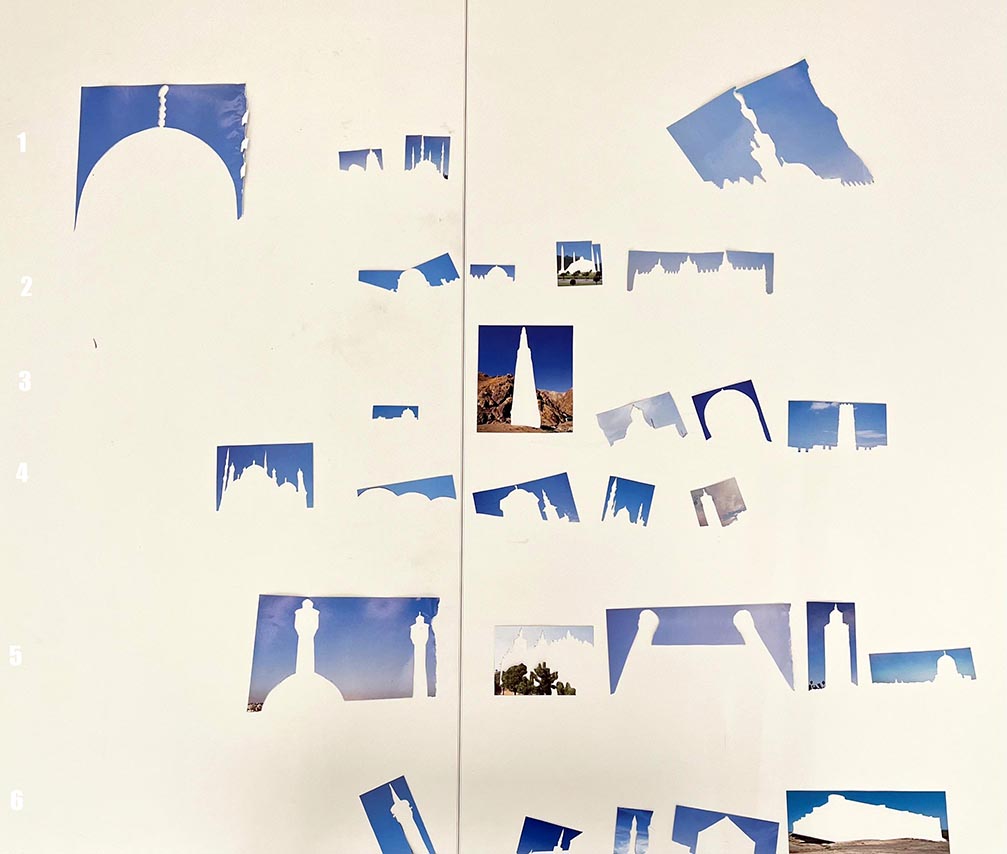
Sa'dia Rehman
Cut Outs
cut out paper,
dimensions variable, 2024
Sa’dia Rehman (they/them) is a multidisciplinary artist and educator focusing on race, empire, and labor. Their work explores the structures of the family, the nation, and the border. Rehman questions how we live within these systems and how they impact who we are, the desire to rearrange and take them apart. They center familial history to expand on harm and survival in an ongoing project tracing their family’s displacement in the late 1960s from an area on the Indus River due to the building of a hydroelectric dam. Rehman has worked on grief, memory, and displacement. Cut Outs, 2024, consists of a congregation of small cut-out papers from a glossy coffee table book titled The Complete Illustrated Guide to Islamic Art & Architecture. In such reference guides, the mosque stands as perhaps the central cultural and religious form of Muslim societies. In this work, Rehman engages with erasure as a marker of place and time. Rehman carefully carves the printed image of well-known mosques, some centuries old, from around the world; what remains are the sky and the land. When Rehman’s father arrived in Corona, Queens, NYC, in 1980, where the artist was born, he ran a halal meat shop and co-founded Masjid Alfalah on National Avenue.
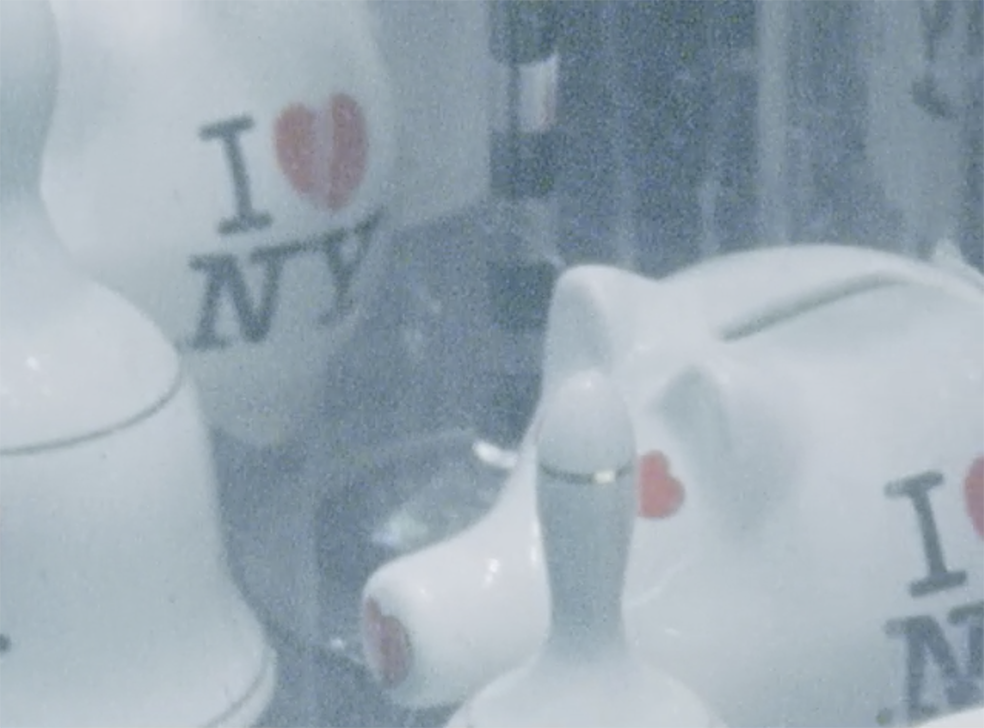
Anto(n) Astudillo
“while I read this letter/mientras leo esta carta”
Medium: 16mm, super8 to digital
Dimension: 4x3 format
Year: 2024
Anto(n) Astudillo (they/he) is a Lenapehoking/NYC-based filmmaker, performance artist, and curator of trans experience from Wallmapu (Santiago, Chile). Astudillo works with 16mm film, video, and performance to create moving portraits of personal and political themes, navigating dynamic interconnections between embodied practices and experimental cinema. In their words ¨For me, queer and trans+ cinema serves as a community, presenting stories within private universes or intimate spaces. It conveys a transformative truth that resonates deeply. ¨. Through the film included in this exhibition ¨I read this letter/mientras leo esta carta¨, Anto addresses their family in Chile to share some of their experiences in the country of residence. This is an exercise inspired by the video-letter format of the AMAME project organized by the Ñukanchik People collective. After 12 years from the artist's decision to emigrate, Anto reviewed their personal archive of moving images captured since their arrival in the United States for the first time.
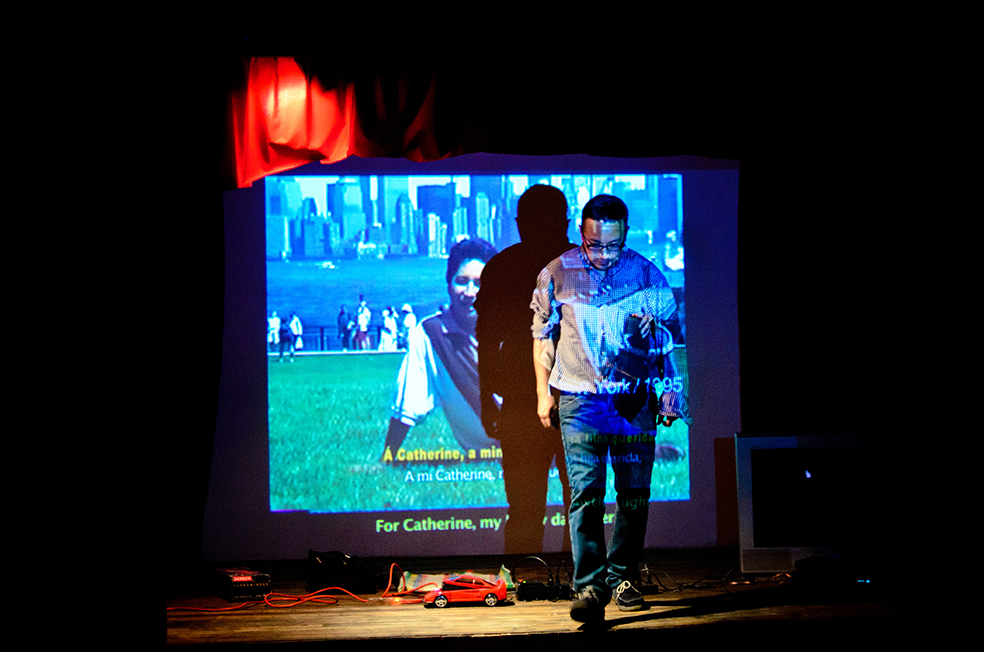
ÑUKANCHIK PEOPLE, Juan Pablo Ordóñez
Lectura Pública (Public Reading)
Performance (video projection, photography, installation)
4m x 2,5m. 2014 – 2024
ÑUKANCHIK PEOPLE Audiovisual Memory of Ecuadorian Migration Archive (Proyecto Archivo de la Memoria Audiovisual de la Migración Ecuatoriana - AMAME). Ñukanchik People is an Ecuadorian art collective, based in Barcelona, Spain, formed by Juan Pablo Ordóñez and Melina Wazhima Monné. One of their main projects is the creation, management, and activation of the Audiovisual Memory of Ecuadorian Migration Archive (AMAME), the creation of Cuerpo Pacífico - Archives of Art in South America, and the generation of the platform ¨En Diaspora Pueblos Transnacionales¨. (In Diaspora Transnational Peoples.). AMAME archive brings hundreds of hours of video letters recorded and exchanged by nearly a hundred families in Ecuador and eleven countries between 1976 and 2010. Among this collection, those from and addressed to Nueva York are particularly numerous; since the 1950s, Ecuadorians have constituted one of the largest diaspora colonies in The United States.
Juan Pablo Ordóñez
Lectura Pública (Public Reading)
Performance (video projection, photography, installation)
4m x 2,5m. 2014 – 2024
For this exhibition, one of the embers of the Ñukanchik People, Juan Pablo Ordoñez, presents the work Lectura Pública (Public Reading), a performance installation in which the artist questions how to read a video letter referring to the video documents in the AMAME archive. Lectura Pública is the repositioning of videos exchanged by Ecuadorian migrant families through the artist's body and action to embody the memories and presence of the people in the archive. Conjugating for it questions about time, discourse and its re-presentation in front of the persistent and cyclical immigrants’ reality.
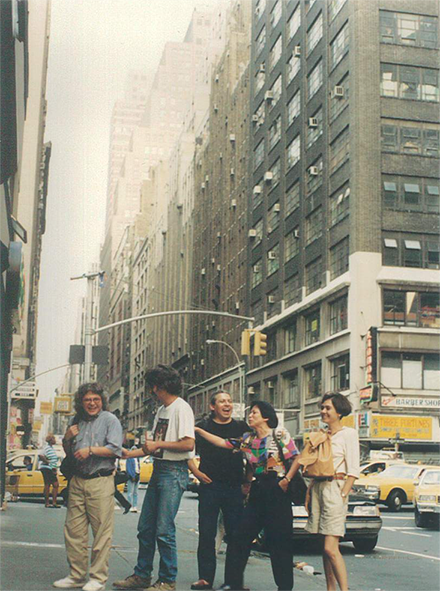
"Poblanos. Voces de Nueva York"Archive document
Error Collective. The documentary collection "Poblanos. Voces de Nueva York" gathers materials inherent to the activities of the homonymous radio program, produced between 1992 and 1993 by Oscar Lopez in collaboration with Enriqueta Silva and Carlos Arellano. The Benemerita Universidad Autónoma de Puebla and the Rockefeller Foundation co-produced the radio program to gather the voices of migrants from Puebla in New York City to discuss the issues that concern their condition. The intention was to be broadcast on community radio stations in both countries, constructing their narratives and producing information, thus constituting an essential and early reference for the historiography of Puebla's migration to New York. The documentary collection is currently undergoing collective research and production, conducted with a group of Mexican artists, and aimed at reflecting from the present on the history of Puebla's migration to New York and documenting the current condition of migrants returning to the state of Puebla. The artists involved in the process are Nina Fiocco, Oscar Formacio, Frida López, María Cerdá Acebrón, César López, Guillermo Serrano, and Claudia Castelán.
The presentation of the archive of "Poblanos in NY. A voice in the multitude," proposed by ERROR (Nina Fiocco and Oscar Formacio) in collaboration with Frida López, brings together archival materials from the original program with discarded objects from the Barrio's pottery workshops of La Luz in the center of Puebla. Through these materials, the aim is to reflect on a metaphorical displacement from Mexican land to the United States and think about the concepts of usefulness and uselessness linked to the workforce and its rights in capitalist logic.
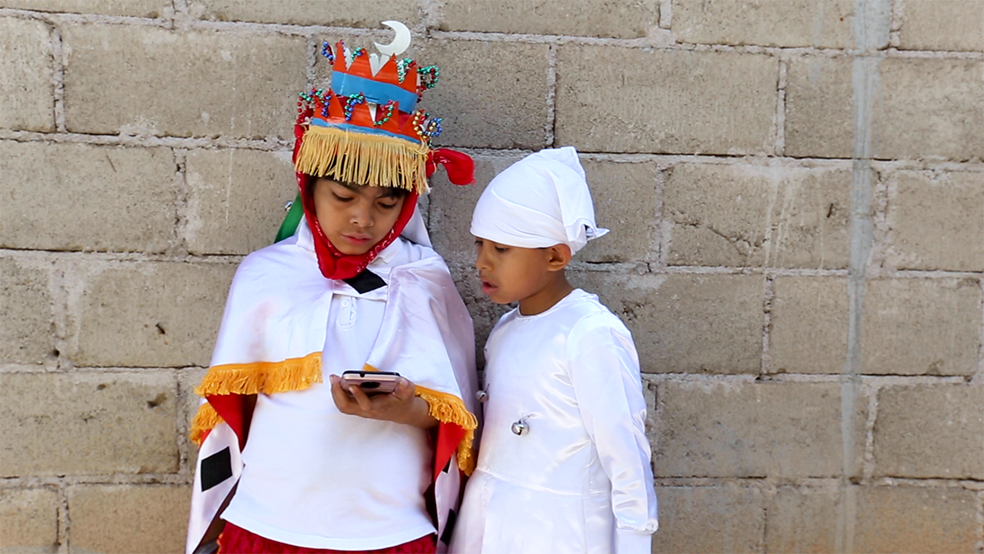
Direction Fernando Valencia y Javier García
Dancing on the other side / Bailando en el otro lado
Production: Sacbe Producciones. 2021.Duration:00:05:19. Sistema NTCS. Resolution HD. Screen16/9. Format MP4. Image Color. Sound stereo / 5.1.
Fernando Valencia y Javier García present the film ¨ Dancing on the other side. ¨ In July 2018, the President Trump administration implemented the zero-tolerance policy, causing the separation of more than 3,000 minors from their families at the Mexican border. While that happened, a children's dance group traveled from New York to Teopantlán, Mexico, the land their parents left decades ago to pursue the American dream. These children born and raised in Queens, NY, used the traditional dance of "Las Moras" as the cultural and political vehicle to hug their grandparents for the first time, to meet their Mexican roots, and with this, erase the existing physical and symbolic borders between those who left Teopantlán and those who stayed. How did these children's and their families' lives change from this trip? "Dancing to the Other Side" explores how this experience marked their lives. Fernando Valencia is Documentary filmmaker and visual anthropologist based in New York City. Javier García is a photographer and documentary filmmaker with studies in music and anthropology.

